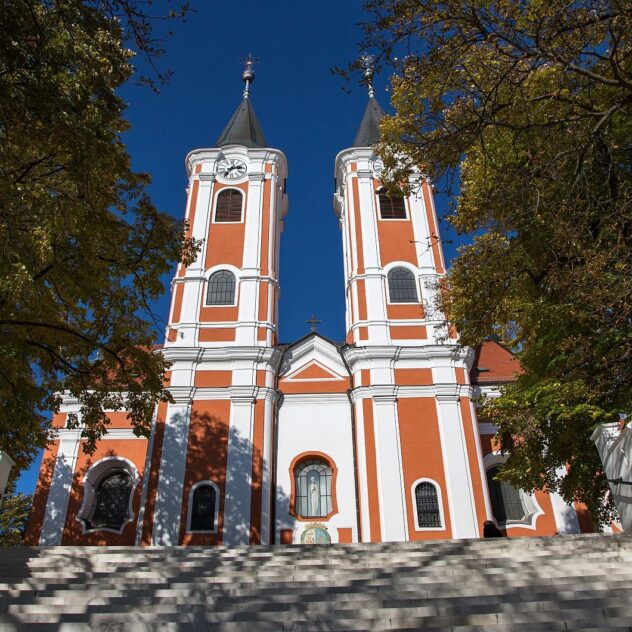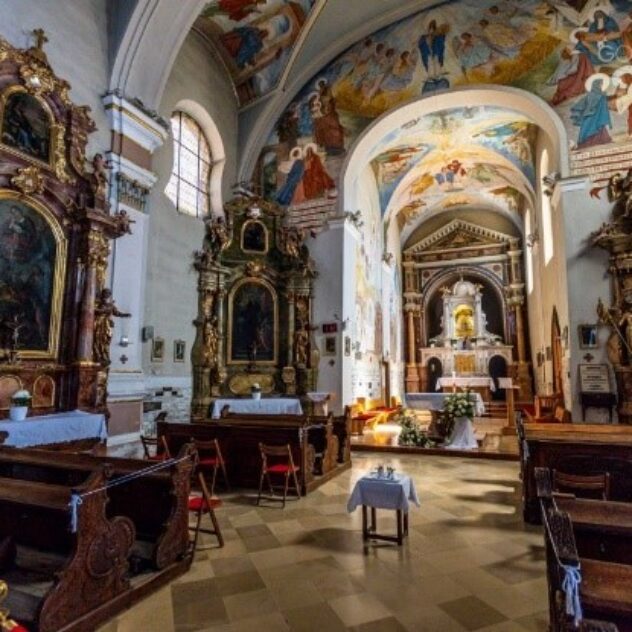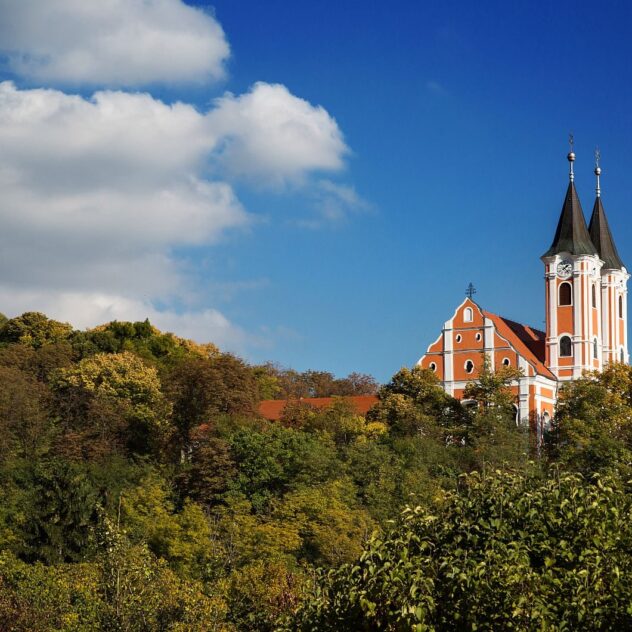Máriagyud
Information about the pilgrimage site
The main attraction of the pilgrimage site is the basilica. In the 14th century, there was already a church on the site, and the remains of this church can still be seen in the present church built in 1739. Above it, there is a large outdoor altar, the scene of major pilgrimages. From there, the Calvary, built in 1751, ascends the hillside. The images of the individual stations were made in the Zsolnay factory.
The region where Máriagyüd is located is diverse and rich in tourist attractions. The Mediterranean-like Pécs has a history dating back to Celtic and Roman times. Sopianae, the early Christian cemetery of Pécs, earned the title of a UNESCO World Heritage Site in 2000. The Pécs Diocese was founded by Saint Stephen in 1009. In addition to its cathedral and memories of the Ottoman era, Pécs attracts tourists with the Zsolnay Quarter and the Zsolnay Collection. The Mecsek Mountains offer excellent hiking opportunities, and the nearby Villány and Szekszárd wine regions, Harkány’s medicinal waters, and Siklós Castle enrich the offerings. Máriagyüd is situated in this rich environment.
The present Marian Statue was donated by bishop William Nesselrode in 1713. From 1739 to 1742 the church was enlarged and reconstructed in baroque style. In 1805 Pope Pius VII. provides the church with privilege of indulgency. In 1846 bishop János Szcitovszky pronounces it an official Marian Sanctuary. In 2008 pope Benedict XVI donates the church the title „basilica minor” that goes with further privileges of indulgency.
Only the walls of the 16th century church’s sanctuary remained. The church gained its present form in 1742. This is the time when the baroque furnishment was prepared. The side-chapel’s statue of Jesus’ Heart, its glass windows and the organ date from the early 20th century, the neo-baroque high altar from 1936, the movable altar and the ambon from the 1970s, the murals covering the cieling and the side walls from 1995-96, the furnishment from 2010.
The surroundings of the church are perfectly suitable for prayer and silence. The Saint Michael’s Chapel dates back to 1742. Built at the place of the medieval sacristy, the Chapel, according to a legend, includes the remains of a benedictine chapel erected in 1006. The statue of Our Lady of Sorrows was erected in 1860. In the same century the stations of the cross were built, with the cemetery and the Jubilee Cross above, erected in 1900. In 1937-38 new statues were prepared. The open-air altar was also built in these years and has since been pronounced, just as the church, a monument.
Domus Mariae, a retreat house, awaits pilgrims. Originally built in 1739 through donations from the faithful, the Franciscan friary was renovated by the Pécs Diocese in 2003 and turned into a pilgrim reception center. The three-story building features a 50-person dining room on the ground floor, and on the upper floors, they have created accommodation for 34 people in two-star tourist hostel category double rooms. The partner restaurant of the pilgrimage house provides discounted meals for guests. The pilgrim house, operational year-round, is open to those seeking spiritual experiences and quiet reflection. In Siklós, there is a rich selection of accommodations for tourists, including a 4-star wellness hotel and guesthouses.
The Laudate Sacred Art and Bookstore opened in the visitor center in 2022. Alongside liturgical tools and sacred images, it offers a broad range of books from church publishers.
The pilgrimage site experiences seasonality in terms of visitor numbers. The season typically runs from April to October, with the highest number of visitors received during the summer months, between May and September. The number of classic pilgrims is relatively low. Many visitors are religious and cultural tourists, likely attracted by the other attractions in the region. Siklós’ historical heritage, Pécs’ cultural offerings, Harkány’s thermal bath, and the famous wine routes draw tourists who complement their itinerary with a visit to Máriagyüd. The pilgrimage site does not have information on the countries or regions of origin of the visitors. Visitors arrive individually and in groups, organized by travel agencies, schools, or individual planning.
Tourist attractions in the vicinity
Siklós Castle – an important historical landmark in Hungary, with its first walls laid in the 13th century, and the first written record dating back to 1294. Several families owned it over the centuries, but it always managed to maintain its significant role. Currently, it hosts various permanent exhibitions and operates a café where visitors can admire Zsolnay decorative objects.
Villány Wine Region – located in the southern part of Hungary, along the border, the Villány wine region lies on the southern and eastern slopes of the Villány Mountains. It comprises 16 villages and is characterized by a sub-Mediterranean microclimate, making it the earliest warming region in the country. The most typical white grape varieties include Olaszrizling, Chardonnay, Riesling, Hárslevelű, and Müller-Thurgau (Rizlingszilváni), while the main red grape varieties are Cabernet Sauvignon, Portugieser, Kékfrankos, Zweigelt, Cabernet Franc, Merlot, and Syrah in smaller quantities.
Harkány Spa – the unique thermal water of Harkány, with temperatures ranging from 50 to 70 degrees Celsius, emerges from depths of 50-70 meters, containing over 1000 mg of minerals per liter. Its most significant mineral for medicinal purposes is carbon sulfide. As the water flows out under pressure, it immediately begins to decompose, transforming into hydrogen sulfide gas, which gives it its distinctive odor. The renovated spa, built in 2003, offers healing in three pools with a total water surface of 2098 m2 and water temperatures ranging from 34 to 38°C.
Pécs Early Christian Burial Chambers – the Cella Septichora, a UNESCO World Heritage Site since 2000, serves as a presentation venue for Early Christian burial chambers. In addition to the Visitor Center, visitors can also see the Early Christian Mausoleum on the corner of Szent István Square and the tombstones on Apáca Street. The Visitor Center features six two-story burial chambers (I, II, III, IV, XIX, XX), and two larger single-room buildings (Cella Septichora and Burial Chamber No. V). The Early Christian Mausoleum and the tomb monuments on Apáca Street are located as separate islands within the UNESCO site.
Zsolnay Cultural Quarter- recognized as a Hungarian cultural heritage, this complex offers exhibitions, historic buildings, entertainment options, and picturesque parks. The Zsolnay family, known for porcelain manufacturing, lived and worked here in the 19th and 20th centuries. The Zsolnay Heritage continues to thrive on a beautifully renovated, 5-hectare site within the world-famous ceramics factory grounds. The Zsolnay Quarter hosts unique exhibitions showcasing the Zsolnay legacy.
Other tourists attractions in the vicinity of the Máriagyud pilgrimage site can be found on the website of Pecs tourism board: https://www.iranypecs.hu/en
Accommodation
- Pútnické ubytovanie: Domus Mariae Spiritual House (http://www.mariagyud.hu/szallas/domus-mariae-lelkigyakorlatos-haz?id=21 ).
- Ďalšie súkromné ubytovanie v blízkosti pútnického miesta.
Availability
By car
Access by car is the fastest and convenient. By car From Budapest it will take approximately 3 hours to reach the Máriagyud pilgrimage site via M6 Highway. You will have plenty of parking space around the Máriagyűdi Bazilika, monument.
By public transport
There is no direct access from Budapest. However there are plenty of Buses and trains from Budapest to one of the Hungarian biggest city Pecs from their there are number of buses availability to reach Máriagyud pilgrimage.
On foot
Additionally each year Pilgram hikers can reach Máriagyűd on foot through the Villány Mountains along the east-west direction of the blue hiking trail and the Miracle Berry educational trail.
On a bicycle
It is also accessible by bicycle from Villány, only 18 km away, with a cycling route traversing the Villány wine region.
Additionally each year Pilgram hikers can reach Máriagyűd on foot through the Villány Mountains along the east-west direction of the blue hiking trail and the Miracle Berry educational trail.








